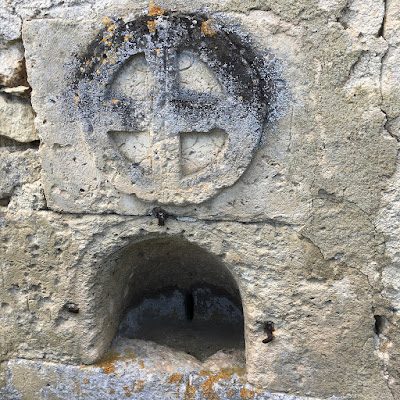Three of us headed out on a gentle morning walk. The sights we saw were just amazing.
 |
| A home in 1617 this building is now the town hall. Yes - you enter by that massive fortified door. Those are nails embedded into the wood to keep invaders from forcing in the wood. |
 |
| The village of La Tour Blanche is the crossroads of two Roman routes. One route goes from Limoges to Bordeaux and the other connects Perigueux to Saintes and Angouleme. |
 |
| Just outside of the village there is a small chapel and a little community where lepers lived. |
 |
| A coin drop for alms for the leper community. |
 |
| In the valley below there were streams that fed the lavoir, the laundromat of days gone by. |
 |
| The surrounding plateau is riddled with quarries. |
 |
| Older quarries were open to the sky. Stone was cut with hand tools. The average size of a stone was 70cm x 40cm x 30cm. Oxen were very important for transportation from the 15 quarries. |
 |
| We were searching for ancient grain pots. These are not on the main road. They are carefully hidden in the woods to protect them from marauders. |
 |
| These are the holes where grains would have been hidden and stored during medieval times. Subtle, but I think you can see them. |
 |
| We passed Chateau de Jovelle from the 14th and 16th century. It looks miserable and yet there is someone living there. |
 |
| La Tour Blanche is still a vibrant community even though it will look crazy old to some of you. |
































2 comments:
What a fabulous walk. And the town is so charming, too. I'm intrigued by those underground grain storage spots and that door is really beautiful. It looks very peaceful but I suspect that once that cafe fills up, the energy level will change a great deal! What beautiful artistic inspiration!
Thanks so much for this tour. I'm not familiar with the things you talked about, so I found the historical facts fascinating. So many sights and things to explore in France.
Post a Comment